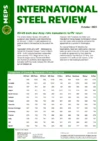Will the last straw break the back of the Ox?
As we approach the Lunar New Year celebrations, heralding the Chinese Year of the Ox, global steel price sentiment is exhibiting signs of weakening.
Steel demand and prices are sliding in China and Turkey. This, in turn, is dragging down the cost of key steelmaking raw materials, such as iron ore and ferrous scrap.
Amid a softening global steel market, the potential for further gains in steel transaction values in Europe and North America is being called into question.
In early January, steel prices accelerated further, continuing the steep upturn that was witnessed throughout December. In the past couple of weeks, however, global sentiment has seen a sharp turnaround.
The cyclical nature of the market and the potential for rapid changes in the cost and, consequently, the availability of raw materials can result in an explosion in steel prices, though rarely matching recent developments. Similar events were seen in 2004 and 2008, but the underlying causes were different.
Mills look to restore margins
No-one would deny that steel mills needed to take advantage of the upward movement and re-establish positive working margins, in order to secure their future, but there is always the temptation to take that one step too far, to put that last straw on the beast of burden’s back. Spot market offers rise as mills try to ‘compensate’ for fixed-price deals.
Within Europe, stainless and carbon steel mills are now seeking to renegotiate contracts or even impose surcharges, believing today that contracts were signed too early. This can create resentment elsewhere in the supply chain.
It was inevitable that the price rally would eventually run of out steam. However, many market participants in Western countries believed that the peak of the cycle would not be reached until at least the middle of 2021. Now, it would appear that the zenith will occur much earlier than previously anticipated.
Turkish slowdown
The earliest signs of a slowdown emanated from Turkey, where mills realised that they could not translate the latest high scrap price into profitable business, in their domestic market and in China. Purchases were suspended but merchants, keen to ship newly collected scrap, lowered price targets, leading to more uncertainty.
However, one factor that is unchanged, at least in Europe and North America, is tight supply. Many buyers continue to find the availability of steel very restricted and mill delivery lead times remain extended. No incentives exist for steel producers to reduce their selling prices, while there is still such a shortage of material.
Whether the global price downturn will be a temporary blip or the start of a prolonged downward correction could largely depend on conditions in the Chinese steel market in the post-Lunar New Year period. Traditionally, demand picks up across Asia, towards the end of the first quarter and beginning of the second, following the Spring Festival celebrations.
Currently, many market participants are doubtful that the Year of the Ox will commence with a bull run. Instead, bearish sentiment is increasingly dominant.

Source:
International Steel Review
The MEPS International Steel Review is an essential monthly publication, offering professional analysis and insight into carbon steel prices around the world.
Go to productRequest a free publication





